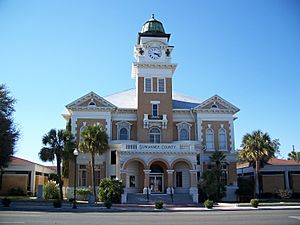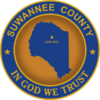Suwannee County, Florida facts for kids
Quick facts for kids
Suwannee County
|
||
|---|---|---|

The Suwannee County Courthouse in Live Oak
|
||
|
||

Location within the U.S. state of Florida
|
||
 Florida's location within the U.S. |
||
| Country | ||
| State | ||
| Founded | December 21, 1858 | |
| Named for | Suwannee River | |
| Seat | Live Oak | |
| Largest city | Live Oak | |
| Area | ||
| • Total | 692 sq mi (1,790 km2) | |
| • Land | 689 sq mi (1,780 km2) | |
| • Water | 3.7 sq mi (10 km2) 0.5%% | |
| Population
(2020)
|
||
| • Total | 43,474 | |
| • Density | 62.82/sq mi (24.256/km2) | |
| Time zone | UTC−5 (Eastern) | |
| • Summer (DST) | UTC−4 (EDT) | |
| Congressional district | 3rd | |
Suwannee County is a county in the north central part of Florida. In 2020, about 43,474 people lived there. This was more than the 41,551 people in 2010.
The main town and county seat is Live Oak. Until 2011, it was a "dry county," meaning selling alcoholic beverages was not allowed. Now, it is legal to sell them.
Contents
History of Suwannee County
Suwannee County was created in 1858. This happened as new railway lines were built. These lines connected the area to cities like Jacksonville and Tallahassee.
The county got its name from the Suwannee River. This river forms most of the county's borders. The name "Suwannee" might come from the Spanish words "San Juan" (Saint John). It could also come from the Cherokee word sawani, meaning "echo river."
Suwannee County in Wars
During the American Civil War, many men from Suwannee County joined the army. They were part of Company K of the 3rd Florida Infantry Regiment.
Later, in 1884, a group called the Suwanee Rifles was formed. They were a volunteer militia. The Rifles were one of twelve Florida companies that served in the Spanish–American War.
In the 1930s, a famous writer and anthropologist, Zora Neale Hurston, studied the lumber and turpentine camps in this rural area.
Geography and Nature
Suwannee County covers about 692 square miles. Most of this area, 689 square miles, is land. Only a small part, about 3.7 square miles, is water.
Neighboring Counties
Suwannee County shares borders with several other counties:
- Hamilton County to the north
- Columbia County to the east
- Gilchrist County to the southeast
- Lafayette County to the west
- Madison County to the northwest
People of Suwannee County
| Historical population | |||
|---|---|---|---|
| Census | Pop. | %± | |
| 1860 | 2,303 | — | |
| 1870 | 3,556 | 54.4% | |
| 1880 | 7,161 | 101.4% | |
| 1890 | 10,524 | 47.0% | |
| 1900 | 14,554 | 38.3% | |
| 1910 | 18,603 | 27.8% | |
| 1920 | 19,789 | 6.4% | |
| 1930 | 15,731 | −20.5% | |
| 1940 | 17,073 | 8.5% | |
| 1950 | 16,986 | −0.5% | |
| 1960 | 14,961 | −11.9% | |
| 1970 | 15,559 | 4.0% | |
| 1980 | 22,287 | 43.2% | |
| 1990 | 26,780 | 20.2% | |
| 2000 | 34,844 | 30.1% | |
| 2010 | 41,551 | 19.2% | |
| 2020 | 43,474 | 4.6% | |
| 2023 (est.) | 46,130 | 11.0% | |
| U.S. Decennial Census 1790-1960 1900-1990 1990-2000 2010-2019 2020 |
|||
In 2020, there were 43,474 people living in Suwannee County. There were 15,149 households and 10,655 families.
Most people in the county are White. There are also many Black or African American people. A growing number of people are of Hispanic or Latino background.
The average age in the county was 40 years old. About 24% of the population was under 18 years old.
Libraries in Suwannee County
Suwannee County is part of the Suwannee River Regional Library System. This system has eight branches and also serves Hamilton and Madison counties.
Library History
The Suwannee River Regional Library was the first regional library in Florida. It started in 1957. Suwannee County joined with Lafayette County to get a special grant for a new library.
A small library opened in Mayo, Lafayette County, in October 1957. It started with 3,100 books and quickly grew. They even added a bookmobile to reach more people.
More counties joined the library system in 1959. These included Columbia, Gilchrist, Hamilton, Madison, and Taylor counties. By 1960, the system had 23,500 books. The main library is in Live Oak, Suwannee County.
Getting Around Suwannee County
Airports
You can fly into Suwannee County using the Suwannee County Airport. It is located two miles west of Live Oak. This airport has a paved runway over 4,000 feet long. It offers aircraft maintenance and fuel.
Railroads
Suwannee County has one active railroad line. It is now part of the Florida Gulf & Atlantic Railroad. This line used to serve Amtrak's Sunset Limited passenger train.
The Union Depot and Atlantic Coast Line Freight Station in Live Oak was once a very important train station. It closed in 1971. Some old railroad lines in the county have been turned into walking and biking trails. One example is the Suwannee River Greenway Trail.
Main Roads
Many important roads run through Suwannee County:
 I-10 (Interstate 10) is a major highway that goes east and west. It has three exits in the county.
I-10 (Interstate 10) is a major highway that goes east and west. It has three exits in the county. I-75 (Interstate 75) runs north and south. It passes through a small part of eastern Suwannee County.
I-75 (Interstate 75) runs north and south. It passes through a small part of eastern Suwannee County. US 27 runs from southeast to northwest. It crosses the Ichetucknee and Suwannee Rivers.
US 27 runs from southeast to northwest. It crosses the Ichetucknee and Suwannee Rivers. US 90 used to be the main east-west road before I-10 was built.
US 90 used to be the main east-west road before I-10 was built. US 129 is the main north-south road. It goes through Live Oak and crosses the Santa Fe and Suwannee Rivers.
US 129 is the main north-south road. It goes through Live Oak and crosses the Santa Fe and Suwannee Rivers. SR 51 is a state highway that runs north towards Live Oak.
SR 51 is a state highway that runs north towards Live Oak.
 SR 136 / CR 136
SR 136 / CR 136 SR 247
SR 247
Towns and Communities
Towns
Other Communities
Images for kids
See also
 In Spanish: Condado de Suwannee para niños
In Spanish: Condado de Suwannee para niños



